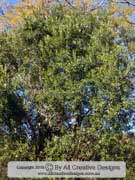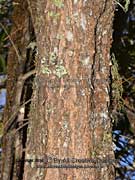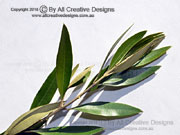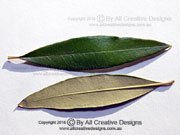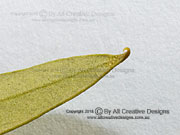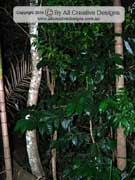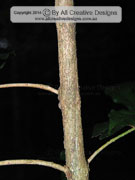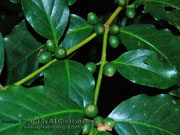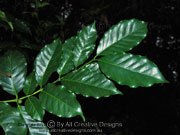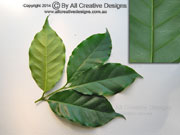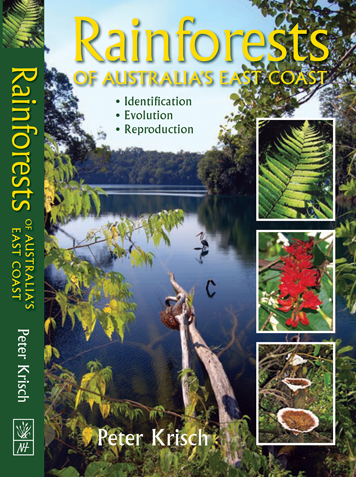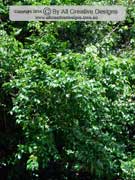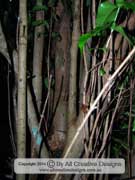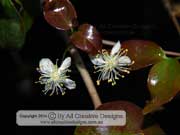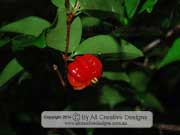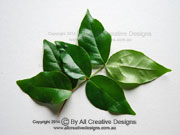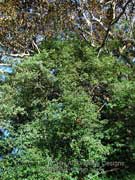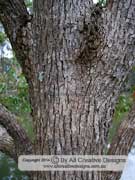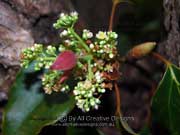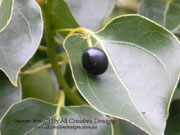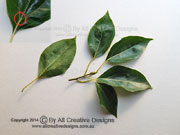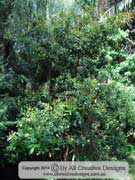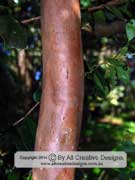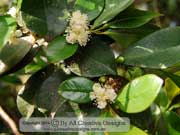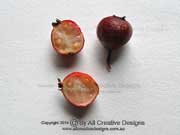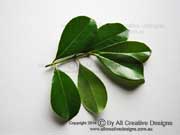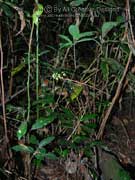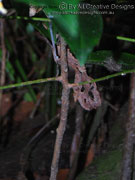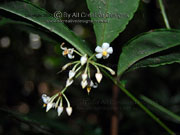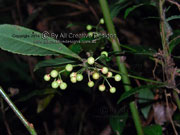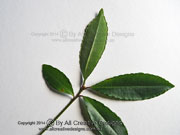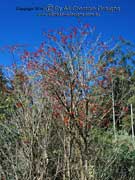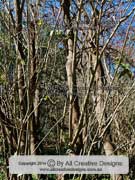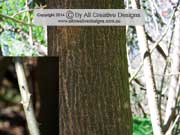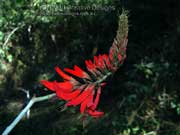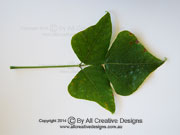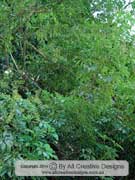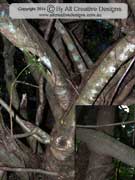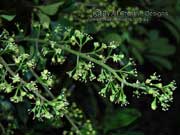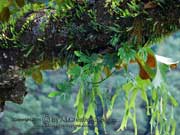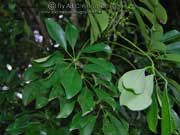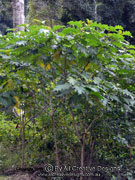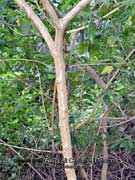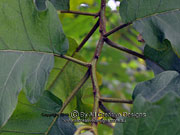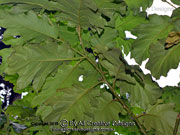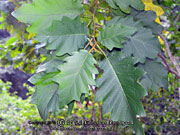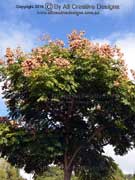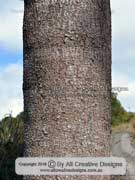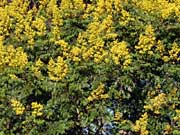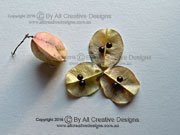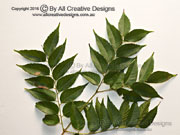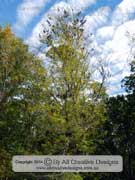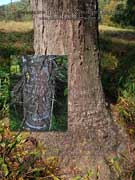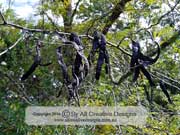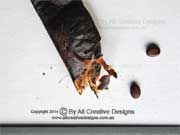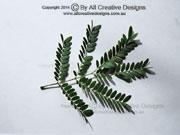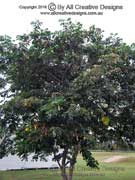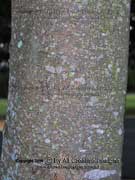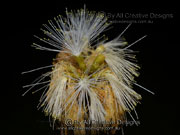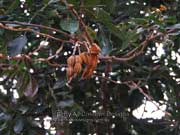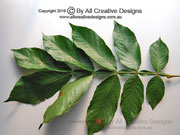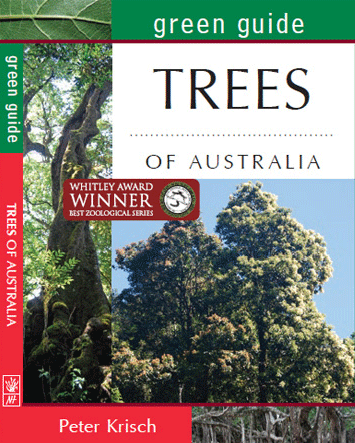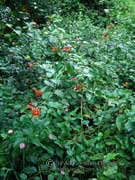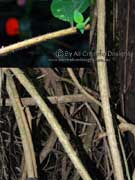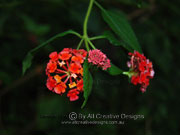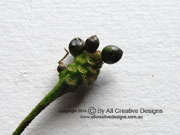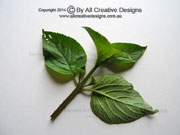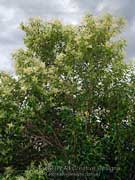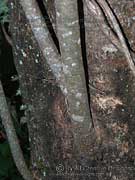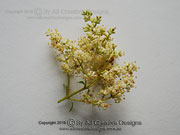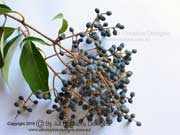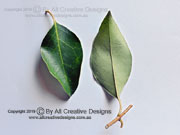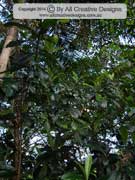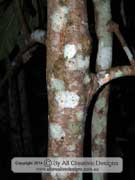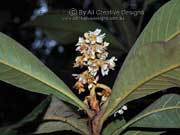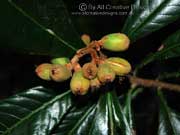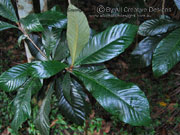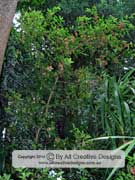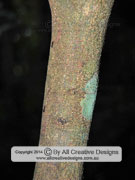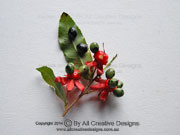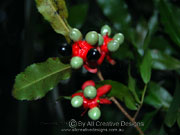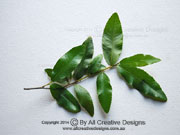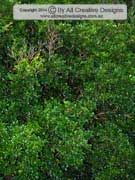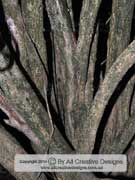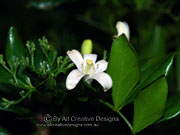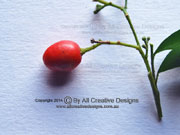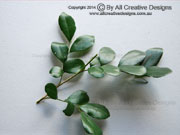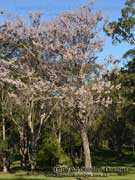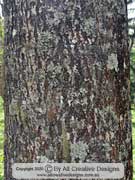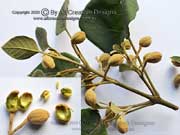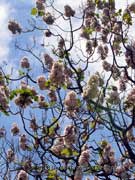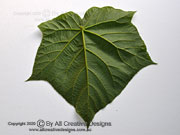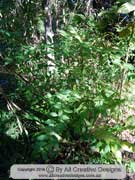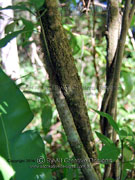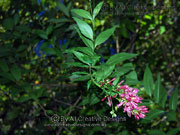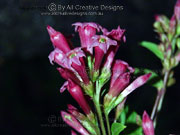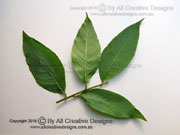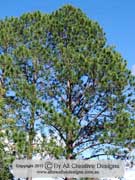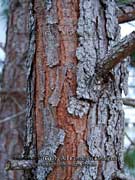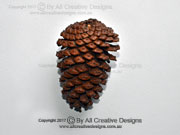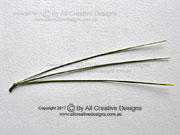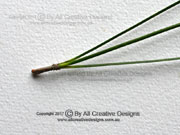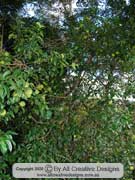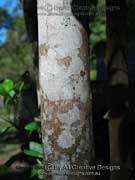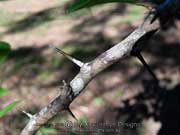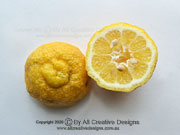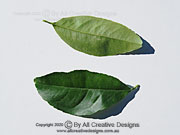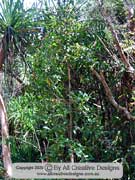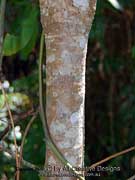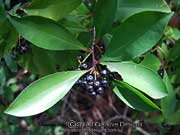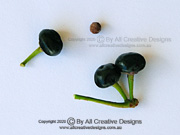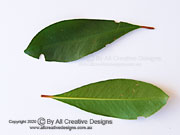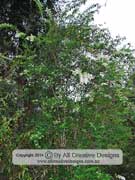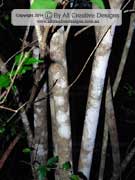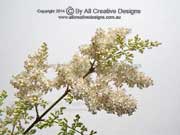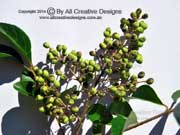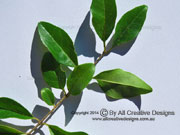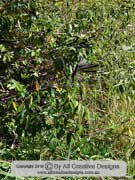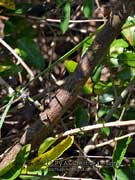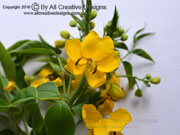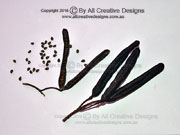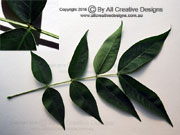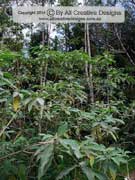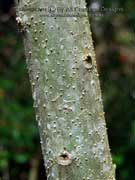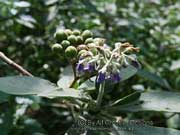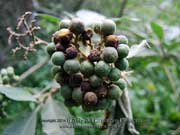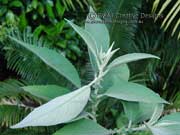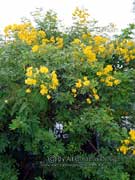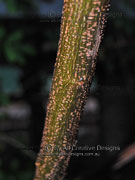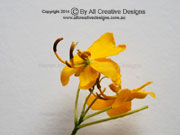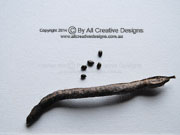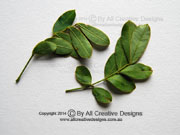
< Expand the Menu to access our Tree Identification Pages
Identify Non-Native, Invasive Trees & Shrubs in Australia
This web page shows enlarged views of full tree, bark, leaf, flower and/or fruit samples of introduced and invasive (sometimes noxious) tree species spreading in Australian forests and woodlands. Detailed descriptions that are useful in identification of non-native, invasive plants are given for each species. All Creative Designs Nambucca & Coffs Harbour® presents web optimized tree images for identification purposes.
The distribution range and special features useful in identification are given for every species listed on the web page below. This free resource is constantly extended, revised and updated.
AFRICAN OLIVE Olea europaea subsp. cuspidata
AFRICAN OLIVE Olea europaea subsp. cuspidata [Olea africana] Other names: Brown Olive, Wild Olive
This tall shrub or small tree rarely reaches a height of more than 10m. Older specimens develop an intricately branching crown and multiple trunks arising from a common base are a regular feature (a suckering habit). It has an extensive natural distribution range that covers most of Africa and parts of Asia (1). Bark on the trunk of older trees is brown and becomes very rough, scaly and flaky. Bark on twigs and young branches is conspicuously covered in small lenticels (blisters) (2). Simple leaves with an opposite arrangement are; up to 10cm long, narrowly elliptic or lance-shaped with entire and in-rolled margins, hairless, dark green glossy on top, paler yellowish or brownish beneath, smooth and leathery in texture. The leaf apex terminates in a stiff curved (hooked) tip (3,4 & 5). The African Olive (Olea europaea subsp. cuspidata) has been reclassified as a subspecies of the European Olive (Olea europaea subsp. europaea). Both subspecies are listed as invasive plants that colonise native forests and woodlands. The European Olive differs in that the undersides of leaves are a silvery grey and by the leaf tip not being hooked. Distribution: SA, Vic., NSW and subtropical Qld. Note: Leaves of the European Olive (subsp. europaea) are reported to have medicinal properties, whereas the effects of constituents in the leaves of the African Olive (subsp. cuspidata) are inadequately researched. The Native Olive (Olea paniculata) is shown on Page 8 and the Long-leaved or Mock Olive (Notelaea longifolia) is listed on Page 7.
ARABIAN COFFEE Coffea arabica
ARABIAN COFFEE Coffea arabica
The ability to germinate and thrive under very low light intensity makes this species from Africa a serious invader of warmer rainforest types on Australia's east coast. In recent times numbers of commercial plantations along the north coast of NSW and backyard plantings of this species have increased, making this species an ever more common occurrence in native vegetation. If not pruned to size, it can grow to the height of a small tree about 10m tall (Picture 1). Bark is cream or more grey coloured and marked by fine longitudinal ridges with a flaky texture (2). The fruit (a drupe) develops single or in groups of up to 5 on individual stalks from axillary buds along the whole length of younger branches. It is ellipsoid in shape (olive-shaped with flattened ends) and up 1.5 cm long, changing from green to a bright red when fully ripe. When the fruit is eaten by native pigeons, doves and other birds, the germination rate of the 2 seeds (coffee beans) per fruit is greatly enhanced (3). Young branches are flattened, rectangular in shape and show stipule scars at leaf nodes (4). Simple leaves with an opposite arrangement are; 15 cm or more long, mostly elliptic in shape with regular wavy margins, hairless, dark green, very glossy on top, paler green, dull beneath, very smooth, rather thin, but leathery in texture. The leaf blade (lamina) is noticeably raised between lateral veins. Apex is long acuminate, base shape is cuneate. Venation is raised on lower leaf surface, showing domatia (inset 5) as hollow swellings along the centre vein (5). Distribution: From NSW mid-north coast to Qld. Temporarily netting plants with ripening fruit in private gardens is recommended.
NEW RELEASE: Rainforests of Australia's East Coast, HAND SIGNED BOOKS; (In Stock) A practical and informative field guide to the identification of native rainforest species. More than 800 colour photographs, informative graphics, maps and detailed description of more than 300 species.
This book is a valuable information source for bushwalkers, students, gardeners and anyone with an interest in Australia’s native flora.
The book was written and illustrated by the author of the tree identification web pages.
New Holland Publishers: May 2019
ISBN: 9781925546293
Format: Paperback with PVC
Pages: 304 pp.
Size: 23 cm high x 15 cm wide
Full Colour Photography
Rainforests: Identification - Evolution - Reproduction
Dedicated photography of rainforest species including; mosses, mushrooms, lichens, slime moulds, ferns, conifers, flowering trees, climbing plants, orchids and palms enable the reader to identify commonly encountered species.
CLICK HERE FOR MORE INFORMATION
BRAZILIAN CHERRY Eugenia uniflora
BRAZILIAN CHERRY Eugenia uniflora Other names: Surinam Cherry
This multi-stemmed shrub or small tree introduced from Brazil is less than 10m tall and used to form hedges or is grown for its ornamental and edible fruit. This species can germinate and grow under the very low light conditions found in different rainforest types. It is an invasive species; in warmer rainforests types, in transitions zones to moist, tall open forests and is often encountered in regrowth along the coastline (Picture 1). Bark on young stems is grey to olive green in colour with a finely rough texture, changing to a greyish pink in colour and to a rather smooth texture on older stems (2). Pure white flowers dominated by yellow topped stamens are held on long, individual stalks and appear over spring (3). The fleshy and edible fruit (a berry) turns bright red in colour when fully ripe and measures up to 2 cm across. Fruit is eaten and dispersed by native birds such as the Satin Bower Bird (4). Simple leaves with an opposite arrangement are; up to 6 cm long, mostly ovate in shape with entire margins, glossy on both surfaces, soft, smooth in texture, scented and sticky when crushed (5). Distribution: North from the NSW mid-north coast. Native replacement species: Lilly Pilly (Syzygium smithii), Powderpuff Lilly Pilly (Syzygium wilsonii ssp. wilsonii) and other Syzygium species.
See Flower Characteristics Page and Leaf Characteristics Page for information on terms used.
CAMPHOR LAUREL Cinnamomum camphora
CAMPHOR LAUREL Cinnamomum camphora Other names Camphorwood
This species introduced from Asia and China is a tall tree with a large, dark green canopy reaching a height of up to 30m. It is very hardy and adaptable to different conditions such as full exposure to sunlight and soil types, but is also able to germinate and develop under low light conditions found within rainforests. By replacing Australian Laurel species it has become an important food source for native birds which disperse the seed (Picture 1). Bark is grey/brown in colour, rough and deeply fissured on older specimens, bark on seedlings is smooth in texture and dark green to nearly black in colour (2). Numerous small flowers are whitish in colour and tightly packed on panicles appearing towards the end of younger branches. Flowering period starts from late winter into spring depending on latitude grown (3). Older trees can produce an abundance of fruit (a drupe) which is a rounded or slightly ovoid shaped, black in colour when fully ripe and measures up to 1 cm in diameter (4). Simple leaves with an alternate arrangement are; up to 8 cm long, broadly elliptic or ovate in shape with entire margins, dark green, glossy on top, pale green to blotchy grey/white (more evident on young leaves) beneath, hairless, not very thick, but strong, rather leathery in texture and strongly camphor scented when crushed. Leaf apex shape is acute ending in a fine point, base shape is rounded. Petiole is yellowish and up to 4 cm long. Three veined from base of leaf blade, where 2 swellings (domatia) on upper surface can be seen (inset 5). Similar to the native Three-veined Laurel Cryptocarya triplinervis (5). Distribution: Has been declared as a noxious weed along the east coast from southern NSW to northern Qld. Native replacement species: Use native Laurel species such as Jackwood (Cryptocarya glaucescens), Murrogun (Cryptocarya microneura).
CHERRY GUAVA Psidium cattleianum var. cattleianum
CHERRY GUAVA Psidium cattleianum var. cattleianum Other names: Strawberry Guava
This species originating from Brazil has become a serious threat to native vegetation in many parts of the world including Africa, warmer parts of North America and Asia. In Australia it has invaded subtropical and upland tropical rainforests, transitions zones and wet tall open forests along the east coast. It is a sturdy shrub or small tree up to 7 m tall which has been planted for its palatable fruit, hardiness and attractive flower display (Picture 1). Fresh bark has a smooth texture and is a reddish brown in colour, weathering to grey before shedding in thin flakes (2). Attractive flowers are held on individual stalks appearing towards the end of young branches. They can reach up to 2.5 cm in diameter and feature 5 rounded petals, pure white in colour and a large number of stamens (3). The fruit (a berry) turns soft and dark red or purple in colour when fully ripe and measures up to 4 cm in length. The whitish fruit flesh contains more than 50 seeds, which will readily germinate after been eaten by a range of different birds and other animals (4). Simple leaves with an opposite arrangement are; up to 8 cm long, obovate in shape with entire (inrolled) margins, very glossy, hairless, rather thick and leathery in texture. Leaf apex is short acuminate, base shape is cuneate. Petiole is up to 15 mm long. Venation is fine and shows about 10 pairs of rather straight lateral veins (5). Distribution: A very invasive species from the NSW north coast to northern Qld.
Native replacement species: Brown Gardenia/Yellow Mangosteen (Randia fitzalanii), Bolwarra (Eupomatia laurina) or Native Guava (Rhodomyrtus psidioides). See Flower Characteristics Page and Leaf Characteristics Page for information on terms used.
Descriptions and all images copyright ©2023 by www.allcreativedesigns.com.au world wide rights reserved.
Click Images for Full Size View
CORAL BERRY Ardisia crenata
CORAL BERRY Ardisia crenata
This invasive species has the ability to germinate and grow in the absence of any direct sunlight found under a closed canopy, which makes it a threat to native understorey species in old growth subtropical rainforests and re-growth areas. It is a sturdy and mostly single stemmed shrub with an upright growth habit up to 2m high, which was introduced from Asia (Picture 1). Bark on older stems is brown in colour with a firm texture marked by small blisters (2). Up to a dozen separate flowers are held in an umbel shaped inflorescence. The common stalk (peduncle) measures up to 5 cm and individual stalks (pedicels) are 2 to 3 cm long. Flowers reach 12 mm in diameter, featuring 5 recurving and white coloured petals with tiny black specks. They bloom over summer into autumn (3). The rounded fruit (a drupe) changes from white, over pink to a vivid red in colour when fully ripe and measures about 1 cm across (4). Simple leaves with an alternate arrangement are; up to 12 cm long, elliptic to slightly oblanceolate (reverse lance-shaped) with crenate, inrolled margins, dark green semi-glossy on top, paler, grey-green beneath, hairless, thick, strong and leathery in texture. Leaf apex is acute ending in a blunt tip, base shape is cuneate. Leaf stalk is about 5 mm long and reddish in colour on young leaves. Except for the midrib, venation is rather faint. Distribution: From the NSW mid-north coast to Qld. Native replacement species: Bolwarra (Eupomatia laurina), Velvet Leaf (Callicarpa pendunculata), Milk Bush (Neisosperma poweri ), Banana Bush (Tabernaemontana pandacaqui). See Flower Characteristics Page and Leaf Characteristics Page for information on terms used.
CORAL TREE Erythrina sykesii
CORAL TREE Erythrina sykesii Other names: Indian Coral Tree, Thorny Coral Tree
Originating from South America this cultivated species has escaped gardens and is now a serious problem weed mainly affecting stream banks and riparian vegetation (re-growth) in moist locations. While this species will not produce any seed in Australia, it still aggressively propagates by means of underground suckers and the ability to regrow even from small pieces being cut up or broken off. It is a small to medium sized tree more than 10m tall, which is deciduous over winter but may still be flowering (Picture 1). If unchecked it can form dense stands on creek and river banks in a relative short time and suppress native vegetation in the process (2). Bark on older trunks becomes soft and corky, whereas young branches are smooth in texture and covered in sharp spines (3). Large numbers of bright red coloured flowers, which are held along racemes measure about 10 cm in length. After opening a bundle of long, purple coloured filaments topped by yellowish green anthers are uncovered. Flowering period is nearly any time of the year (4). Trifoliate compound leaves feature 3 leaflets, which are; up to 15 cm long, triangular in shape with entire margins, hairless, dull on both surfaces and firm in texture. Leaf apex is acuminate ending in a fine tip, base shape is truncate. The very straight and rigid leaf stalk can be more than 15 cm long, leaflet stalk is up to 1 cm long. Pinnate venation is clearly visible on both surfaces (5). Distribution: Coastal NSW & Qld, and possibly other states.
Native replacement species: Water Gum (Tristaniopsis laurina), Creek Sandpaper Fig (Ficus coronata), Cheese Tree (Glochidion ferdinandi) for stream banks; Firewheel Tree (Stenocarpus sinuatus), Tree Waratahs for landscaping purposes.
DWARF UMBRELLA TREE Schefflera aboricola
DWARF UMBRELLA TREE Schefflera aboricola
This species was introduced from Taiwan as an ornamental garden species and is a close relative to the native Umbrella Tree Schefflera actinophylla (See Page 11). It has the strangler like ability to overtake a host tree and thereby reaching a height of 20m or more (Picture 1). A short, stout trunk supporting intertwining limbs and an extensive aerial root system, able to invade nearby native trees, will develop on older specimens. The inset in picture 2 shows a Dwarf Umbrella Tree root anchored on the trunk of a Brush Cherry (Szyzgium australe). Bark is grey in colour on older limbs to more olive green on young growth, and apart from some blisters (lenticels) firm and rather smooth in texture, (2). Pale yellowish green coloured flowers are held in groups of 5 along large terminal panicles appearing over autumn. 5 or 6 strong filaments topped by broad, white coloured anthers are characteristic (3). Prolific fruit production and the ability to start life as an epiphyte makes this species a threat to warmer types of rainforests, the image shows an emergent of the Dwarf Umbrella Tree on a Moreton Bay Fig (Ficus macrophylla) (4). Palmate compound leaf are made up of 6 to 10 individual leaflets, which are; up to 10 cm long, broadly oblanceolate in shape with entire margins, hairless, dark green, glossy on top, dull, pale whitish green beneath, smooth and rather leathery in texture. Leaf apex is short acuminate or acute ending in a blunt tip, base shape gradually tapers. Leaflet stalks (petiolules) are up to 3 cm long. The rigid leaf stalk (petiole) is up to 16 cm long and exudes a clear sticky sap when broken. Venation is fine, but visible on both surfaces (5). Distribution: Spreading from the mid-north coast of NSW to Qld. Native replacement species: Tuckeroo (Cupaniopsis anachardiodes), which is also very hardy and tolerant to full sunlight.
See
Leaf -
Flower - Fruit - and Bark Identification Web Pages for explanations of botanical definitions and concepts.
Select images for Full Size View. (Opens new browser window).
Use the Key to Species, which is based on leaf characteristics, to identify native trees and shrubs found on Australia's east coast.
GIANT DEVIL'S FIG Solanum chrysotrichum
GIANT DEVIL'S FIG Solanum chrysotrichum
This adaptable long-lived shrub invades the margins of rainforests and many drier environments from temperate to subtropical regions in Australia. It is a member of the very diverse Solanum genus, which not only includes more than 150 native plant species, but also a number of invasive exotic species, such as the noxious WILD TOBACCO BUSH Solanum mauritianum listed below on this page. Fertile soils on the margins of rainforest or within disturbed rainforest areas are habitats in which single-stemmed specimens can reach a height of up to 6m (a small tree) (Image 1). Bark is beige and except for stout sharp prickles and some blisters is relatively smooth in texture (2). Branchlets (young twigs) and petioles (leaf stalks) are covered in rusty brown hair and scattered prickles. Simple leaves have an alternate arrangement, with sometimes 2 leaves emerging from the same node (3 & 4). Leaves are; up to 35cm long, ovate or broadly elliptic with deeply lobed margins, hairy, dark green on top, paler green beneath, relatively soft but also strong in texture. Leaf base shape is often asymmetric. Pinnate venation is very prominent (5). Distribution: Vic., NSW and subtropical Qld. Introduced from Central America.
GOLDEN RAINTREE Koelreuteria elegans
GOLDEN RAINTREE Koelreuteria elegans subsp. formosana Other names: Chinese Flame Tree, Chinese Rain Tree
This species, imported from Taiwan, is widely used as a street tree and planted in suburban gardens in many parts of Australia. In cultivation it is rarely more than 10m tall, but in a native forest situation it may reach 20m when competing for available sunlight (1). Bark is brown in colour weathering to grey on the outer surface. On older trunks bark becomes rough, scaly (tessellated) and furrowed in texture (2). Large upright panicles (a multi-branching inflorescence) appear at the very end of branches (terminal) and bear numerous bright yellow flowers up to 2cm in diameter (3). The fruit, a papery capsule, is about 5 cm long and changes from a yellowish green and pink to brown at full maturity. It opens into 3 valves each holding 2 rounded and black coloured seeds (4). The large bipinnate (twice-divided) compound leaf can feature more than 60 individual leaflets, which are; up to 10 cm long, broadly lance-shaped (lanceolate) or ovate (egg-shaped) with toothed to nearly entire margins, mostly hairless, dull mid-green on top, only slightly paler green beneath and firm in texture. Leaflet apex is acuminate, base shape is rounded. The mid rib and curved laterals are prominently raised on lower leaflet surface (5). Distribution: Reported to have invaded native habitat in northern NSW and southern Qld, and is on a weed alert for warmer regions all over Australia. Native replacement species: Tulipwood (Harpullia pendula), White and Pink Euodia (Melicope spp.), Cheese Tree (Glochidion fernandi) and Lilly Pillies, Satinashes (Syzygium spp.). Note: The closely related Koelreuteria paniculata shares the common name with the species described and differs that leaves are pinnate (only once divided). It is probable that Koelreuteria paniculata has similar invasive qualities. See Leaf Characteristics Page for information on botanical terms used.
HONEY LOCUST Gleditsia triacanthos
HONEY LOCUST Gleditsia triacanthos
This species introduced as a fodder tree to Australia in the 19th century was made more popular by the perma culture
movement in the late 1980th for its nitrogen fixing ability. Native to North America, it is a deciduous and fast growing tree reaching up to 25m in
height, preferring moist locations such as stream banks and wet forests (Picture 1). The trunk flaring at the base can be
covered in branching and very sharp spines more than 20 cm long, individual spines are also present on young branches. Bark is brown in colour weathering to grey, very rough and extremely
hard in texture (2). Masses of flat seedpods are produced over autumn, which can reach more than 40 cm in length. They change from green to a dark brown colour and a hard consistency when fully ripe. The seedpod will not split on the tree, but decays on the ground where it can be washed away by heavy rains or floods (3). A single seedpod can contain up to 30 seeds enclosed in a very sticky and sweet smelling pulp. Seeds are flat and ovoid in shape, shiny brown in colour and up to 12 mm long (4). Bipinnate compound leaves are up to 25 cm long with mostly 3 or 4 pairs of pinnae holding up to 30 separate leaflets, which are; up to 2 cm long, oblong or elliptic in shape with entire margins, hairless, dark green, dull on top, paler, yellowish green beneath, thin but quite strong in texture. Leaf apex is rounded showing a very fine tip (mucronate), base shape is obtuse. Leaflet stalks (petiolules) are about 2 mm long. Fine reticulate venation is visible with a lens (5). Distribution: Often invading stream banks in subtropical NSW and Qld. Note: There are a number of different cultivars in existence, which might be spineless and feature pinnate compound leaves with larger leaflets. See Leaf Characteristics Page for information on terms used. Native replacement species: Cheese Tree (Glochidion ferdinandi ), Water Gum (Tristaniopsis laurina) and Creek Sandpaper Fig (Ficus coronata).
Ice Cream Bean Inga edulis
ICE CREAM BEAN Inga edulis
The striking appearance of flowers, the edible fruit and its hardiness are reasons for the popularity of this medium sized tree in horticulture. It was introduced from Central America and has become an invasive species in the subtropical regions of northern NSW (1). Bark is firm in texture, marked by closely spaced small horizontal ridges, and grey in colour (2). Flowers feature prominent filaments which are pure white at first, changing to a cream colour with age. They are up to 5 cm long and support small yellow anthers (3). The fruit, a flattened and ribbed pod, is up to 20 cm long, brown in colour and hairy on the outside. It contains a sweet white pulp and edible seeds (4). The pinnate compound leaf consists of up to 12 leaflets, which are; up to 15 cm long, mostly broad elliptic in shape with entire margins, dark green and hairy on top, paler green and sparsely hairy beneath, strong and firm in texture. The leaf rachis is characteristically winged and also hairy (5). Distribution: Mid-north coast of NSW to southern Qld. Native replacement species: Native Tamarind (Diploglottis australis ), Pink Lace Flower (Archidendron grandiflorum).
green guide TREES OF AUSTRALIA
How to recognise Australian tree families and genera.
A practical field guide to the identification of native species. More than 200 full colour photographs and detailed descriptions explaining leaf, bark, flower, fruit and other tree characteristics. The guide was written and illustrated by the author of these web pages.
New Holland Publishers: January 2016
Format: Paperback with PVC
Pages: 128 pp.
Size: 13 cm wide x 18 cm high
First Edition, Hand Signed Copies
CLICK HERE FOR MORE INFORMATION LANTANA Lantana spp.
LANTANA Lantana spp.
The prolific growth rate, an abundance of fruit produced at any time of the year and its toxicity to livestock make this shrub a weed of national significance. Originating from South America it was introduced to Australia in the early 19th century and has become very widespread on margins of different rainforest types, within moist tall Eucalypt forests, riparian vegetation, along stream banks and roadsides. Old growth rainforest with a dense canopy does not allow enough sunlight to reach the forest floor for lantana to germinate and plants to develop, but any openings in the canopy caused by logging or natural causes are quickly colonized. Lantana can not only form dense free standing thickets overgrowing and killing native vegetation, but is also able to climb and cover small to medium sized trees (Picture 1). Bark on young stems is covered in sharp prickles which can cause skin irritation when touched (inset 2). Bark on older stems changes to a softer texture, loses the prickles and shows longitudinal fissures (2). Umbel shaped heads on long stalks hold 20 or more individual flowers in a range of colours, where the red flowered variation (shown) is the most toxic to livestock (3). The fruit (a drupe), less than 1 cm long, turns soft and a glossy black in colour when fully ripe (4). Simple leaves with an opposite arrangement are; up to 8 cm long, ovate in shape with finely toothed margins, mid to dark green, very rough on top, paler green, softer and hairy beneath. Leaf apex is acute, base shape is rounded or cordate. Petiole is between 1 and 2 cm long. Venation is prominent and raised on lower leaf surface (5). Distribution: A serious noxious weed in NSW and Qld.
Note: The constant spread of Lantana had a detremental effect on a number of native shrubs, such as the Brush Wedding Bush (Ricinocarpos speciosus) Page 2 and the Velvet Leaf (Callicarpa pendunculata) Page11. Native replacement species: Any dense plantings of native trees, shrubs or groundcovers to create a deep shade.
LARGE-LEAVED PRIVET Ligustrum lucidum
LARGE-LEAVED PRIVET Ligustrum lucidum Other names: Broad-leaved Privet, Chinese Privet
Under ideal conditions this species of privet can reach the height of a medium sized tree (20m). It has invaded many native wet habitats including rainforests along Australia’s east coast. Prolific flowering over spring and summer (depending on latitude) produces a distinct pungent smell, which together with the abundant fruit identifies this species (Image 1). Bark is greyish brown and on older trunks becomes fissured and somewhat scaly. Younger branches are a more greenish colour, relatively smooth and covered in lenticels (2). Large panicles appear at the very end of branchlets and bear copious amounts of flowers, which are white at first, then changing to cream with maturity. Bisexual flowers feature a corolla (floral) tube that splits into 4 pointed lobes at the apex and only 2 stamens with conspicuous anthers (3). The succulent fruit (a drupe) turns dark blue to nearly black at full maturity and contains mostly 2 hard-shelled seeds. It is reported to be toxic to humans and livestock (4). Simple leaves with an opposite arrangement are; up to 12cm long, varied in shape from broadly elliptic to more ovate with entire margins, dark green and glossy on top, paler greyish green and dull beneath, smooth and leathery in texture. On the lower leaf surface, venation is indistinct and the centre vein is noticeably raised (5). Distribution: Vic, NSW & Qld (introduced from Asia and declared a noxious weed). See also; Small-leaved Privet (Ligustrum sinense) below on this page.
LOQUAT Eriobotrya japonica
LOQUAT Eriobotrya japonica Other names: Japanese medlar, Bibasse
This species originating from China has a long history of naturalisation in warmer parts around the world and has also become a weed problem along Australia's east coast. It is a tall shrub, which under favourable conditions can reach the height of a small tree with large glossy leaves crowding at the end of branches. It will invade a range of different habitats including; warmer types of native rainforests, transition zones, wet tall eucalypt forests, riparian vegetation (regrowth) and stream banks (Picture 1). Bark on older stems is a light grey in colour and has a firm, finely rough texture due to small hard blisters and fine cracks (2). Scented flowers appearing in autumn feature 5 white petals supported by a hairy calyx and stalk. Individual flowers measure up to 15 mm in diameter and are held on panicles springing from the very end of young branches (terminal) (3). The oval or pear shaped fruit can be very palatable on cultivated trees, but is often underdeveloped and acidic in taste when growing as an understorey species or when being exposed to mild frosts. Even under-developed fruit can produce viable seeds which a spread by birds and other animals (4). Large simple leaves first cluster at the end of young branches, then turn to an alternate arrangement. Mature leaves are; up to 25 cm long, oblanceolate in shape with toothed margins, dark green, glossy, hairless on top, yellowish green, densely hairy beneath, strong and leathery in texture. Leaf apex is acute, base gradually narrows to a rounded or cordate shape. Mid rib and lateral veins are yellowish in colour, prominently raised and covered in fine rusty hair on lower leaf surface (5). Distribution: Coastal NSW and Qld. Native replacement species: Davidson's Plum (Davidsonia jerseyana & Davidsonia pruriens) Page 3.
Descriptions and all images copyright ©2023 by www.allcreativedesigns.com.au world wide rights reserved.
Click or Tap Images for Full Size View
MICKEY MOUSE PLANT Ochna serrulata
MICKEY MOUSE PLANT Ochna serrulata
This vigorous shrub from South Africa is very adaptable to different habitats ranging from stream banks within rainforests to dry and exposed locations on poor soils. It can grow up to 4m when competing for available sunlight beneath a closed forest canopy, but under less favourable conditions it only reaches about 2m in height at full maturity (Picture 1). Bark on older stems is brown in colour with a finely rough texture due small horizontal blisters (lenticels) and fine vertical ridges (2). The unusual fruit (a drupe) sits on top of a swollen and bright red coloured receptacle showing 5 pointed sepals (remains of the flower). The egg-shaped drupe is up to 5 mm long and changes from a light green to a shiny black colour when fully mature in late spring and summer (3 & 4). Simple leaves with an alternate arrangement are; up to 6 cm long, oblong to elliptic in shape with finely serrated margins, hairless, dark green, semi-glossy on top, paler green, dull beneath, strong, slightly rough and rigid in texture. Leaf apex is acute, base shape is cuneate (wedge-shaped). Short leaf stalk is less than 3 mm long. All veins are very visible and raised on upper leaf surface. Distribution: From south coast of NSW to northern Qld. Native replacement species: Hairy and Smooth Lollybush (Clerodendrum tomentosum Page 7 or Clerodendrum floribundum), Brush Pepperbush (Tasmannia insipida) Page 2 for shaded areas.
ORANGE JASMINE Murraya paniculata
ORANGE JASMINE Murraya paniculata Other names: Mock Orange, Murraya
This attractive shrub or small tree introduced from Asia is widely used in landscaping as a screening plant, but has found its way into different kinds of native rainforests and adjoining wet tall open forests. If not pruned and especially under a canopy reaching for light, it can reach more than 10m in height (Picture 1). Bark on older stems is grey in colour and becomes rough and furrowed (2). Scented flowers measure about 1.5 cm in diameter and feature 5 pure white, oblong shaped petals, which will bend backwards when fully opened. In the centre a solid style is crowned by a large, yellow coloured stigma and surrounded by up to 10 stamens with white filaments. The extended flowering period lasts from winter to summer and sporadically over autumn (3). The egg-shaped fruit (a berry) is up to 15 mm long and turns a bright red colour when fully mature. It is eaten and widely dispersed by a range of native birds (4). Pinnate compound leaves feature up to 10 leaflets, which are; up to 6 cm long, mostly obovate in shape with entire margins, hairless, dark green, glossy on top, paler green beneath, strong, leathery in texture and orange scented when crushed. Leaflet apex is short acuminate with a blunt tip to nearly rounded, base shape is cuneate (wedge-shaped). Fine venation is more visible on lower leaflet surface, showing up to 6 or 7 pairs of lateral veins. Leaflet stalks (petiolules) are up to 3 mm long (5). Distribution: From mid-north coast of NSW to northern Qld. Native replacement species: Native Syzygium species (Lilly Pilly) Page 10, Brown Gardenia/Yellow Mangosteen (Randia fitzalanii) Page 2, Black Plum (Diospyros australis) Page 1.
PRINCESS TREE Paulownia tomentosa
PRINCESS TREE Paulownia tomentosa Other names: Paulownia, Foxglove-tree, Chinese Empress Tree
The Princess Tree was introduced to Australia as a fast-growing plantation tree that produces valuable timber, but is now regarded as an invasive species. The Paulownia is deciduous over winter and reaches a height of up to 25m. It doesn’t reach this height as an ornamental tree planted in open spaces (Image 1). Bark is firm, rough and fissured; bark colour is brown with ridges weathering to grey. Lichens obscure the surface (2). The image shows densely hairy flower buds before opening, the inset shows the ovary and style within the bud (left). Stamens are exposed to the right (3). After a period of being leafless (deciduous) masses of flowers are borne on panicles up to 30cm long, which appear in terminal positions, i.e. at the end of young branches. Individual flowers are up to 6cm long, pale violet or purple to nearly white with coloured hues and resemble a Fox Glove flower. The floral tube is hairy and splits into 5 re-curving lobes at the apex (Images 1 & 4). Simple leaves with an opposite arrangement are; more than 20cm long, heart-shaped with broadly toothed, lobed to nearly entire margins, woolly hairy when young, normally hairless and firm when mature. The straight and rigid petiole (leaf stalk) is up to 20cm long. Venation is very distinctive and prominently raised on lower leaf surface (shown) (5). Distribution: Regarded as an invasive species in areas of Vic, NSW and Qld. Introduced from China. Note:
https://keyserver.lucidcentral.org/weeds/data/media/Html/paulownia_tomentosa.htm
PURPLE CESTRUM Cestrum elegans
Purple Cestrum Cestrum elegans Other names: Crimson Cestrum, Elegant Poison-berry, Red Cestrum
A minimum of 4 different cestrum species are listed as noxious weeds in Victoria, New South Wales and Queensland. They are; the Red Cestrum C. fasciculatum, Green Cestrum C. parqui with greenish yellow flowers, the Night Jasmine C. nocturnum with white flowers that release an overpowering scent after dark, and the Purple Cestrum C. elegans shown here. All are multi-stemmed, hardy and vigorous shrubs up to 4m tall, which are native to Central and South America. They have been planted for their showy flowers which bloom over a long period in warmer climates. These species have invaded native habitats such as; transition zones around rainforests, tall moist Eucalypt dominated forests (sclerophyll forests), stream banks and re-growth areas (1). Bark on older stems is covered in corky blisters (lenticels) and olive-green in colour (2). Flowers are borne on tightly packed panicles at the very end of young branches. Colours can be purplish, pink or more crimson. The pronounced calyx features pointed lobes and is hairless (glabrous).The trumpet-shaped corolla is glabrous, up to 2.5 cm long and splits into 5 or 6 triangular lobes at the apex to expose bright yellow anthers and a green stigma in the centre (3 & 4). Simple leaves with an alternate arrangement are; up to 12 cm long, broadly lance-shaped (lanceolate) with entire margins, dull, dark green on top, paler beneath, hairless on both surfaces, rather thin and soft. The smooth petiole is up to 15mm long. The prominent mid rib and curved laterals are raised on the lower leaf surface (5).
Note: Confusingly the common name Red Cestrum is also used for the Purple Cestrum Cestrum elegans shown here. The Red Cestrum C. fasciculatum differs in that the flowers are reported to be densely hairy (pubescent). For more information see resources at the bottom of this page.
To locate trees by botanical name or to find related species go to:Species List Botanical, which also shows all family names.
RADIATA PINE Pinus radiata
RADIATA PINE Pinus radiata Other names: Monterey Pine
The Radiata Pine is one of 5 species belonging to genus Pinus that are listed as invasive weeds in Australia. The Radiata Pine, native to the west coast of the USA, is grown in plantations around Australia for its softwood timber, which is widely used in the building industry. This species has naturalised in many parts of the country as the winged seeds are ideal for aerial dispersion. It is a tall tree reaching heights of more than 30m with distinctive needle-like foliage (1). Bark is a reddish brown in colour weathering to grey on the outer surface. It has a rough texture and becomes deeply furrowed at the base of older trees (2). The oblique shape and the offset centre of the curved stalks’ attachment to the woody female cone are vital characteristics in identification. Individual cone scales feature a sharp prickle at the apex. The female cone is up to 17 cm long and about up to 8 cm in diameter. Female cones will take up to 2 years to mature (3). Foliage is made up of three (sometimes only 2) needle-like leaves up to 15cm long that are held together by a sheath at the base (4 & 5). Distribution: In native open forests of NSW, Qld., WA, SA, Tas., Vic. and ACT.
ROUGH LEMON Citrus x taitensis
ROUGH LEMON Citrus x taitensis Other names: Bush Lemon, Wild Lemon, Rangpur Lime
This member of the Citrus genus originates in Asia and has naturalised in many parts of the world. In Australia it has invaded subtropical and warm temperate forms of rainforests and other drier environments. It is a tall shrub or small tree up to 6m tall that has the ability to flourish in shaded areas beneath taller rainforest tree species (Image 1). Bark on the lower trunk is olive green/brown (grey colouring is caused by lichens) and finely rough due to small fissures and raised wrinkles (2). Sharp spines are present on branches and can reach a length of 30mm, but normally disappear from older trunks (3). The edible fruit, a berry, is irregularly rounded and up to 10cm long. The rough pimpled and thick skin turns yellow or sometimes orange red at full maturity. A broad rounded protrusion at the apex is common. The berry is divided into 8 to 10 segments and seeds are up to 12mm long. The fruit is eaten by birds and fruit bats which disperse the seeds over wide areas (4). Simple leaves with an alternate arrangement are; up to 12cm long, elliptic in shape with crenate to nearly entire margins, hairless, dark green and glossy on top, strongly scented when crushed. Translucent oil dots are clearly visible (5). Distribution: South coast and tablelands of NSW to southern Qld. Note: Citrus x taitensis is used as a root stock for grafted citrus fruits.
SHOE-BUTTON ARDISIA Ardisia elliptica
SHOE-BUTTON ARDISIA Ardisia elliptica Other names: Coralberry, Duck’s Eye, China Shrub
Due to its attractive appearance, this very adaptable species has been planted as an ornamental shrub but it has invaded many native habitats, which include rainforests. It is a sturdy shrub or sometimes small tree that reaches a height of up to 6m. The Shoe-button Ardisia is native to India and south eastern Asia (Image 1). Bark on trunks is brown and firm, marked by small vertical ridges and rounded protrusions (lenticels) (2). The succulent fruit (a drupe) turns black with full maturity and measures about 10mm across. Usually multiple individually stalked fruits are attached to a primary stalk at a central point (umbellate). The hard-shelled seeds are globose (round) and about 5mm in diameter. Fruit are eaten and the seed dispersed by various birds (3 & 4). Simple leaves with an alternate arrangement are; up to 13cm long, oblanceolate (reverse lance-shaped) with entire margins, hairless, dark green on top, paler green beneath, thick and firm. The petioles (leaf stalks) and branchlets (twigs) are an distinctive pinkish red colour (5). Distribution: From north eastern to south eastern Qld, NSW far north coast? Note: The closely related Coral Berry (Ardisia crenata) is listed towards the top of this page.
See Fruit Characteristics Page for information on terms used.
SMALL-LEAVED PRIVET Ligustrum sinense
SMALL-LEAVED PRIVET Ligustrum sinense
This species was introduced from China and has spread into a range of native forest types and is common as riparian vegetation after clearing along gullies and stream banks. It is a vigorous large shrub or multi-stemmed small tree up to 10m tall. It has a prolific reproduction rate due to the large amounts of fruit and viable seeds produced (Picture 1). Bark on older stems is grey in colour, hard and finely rough in texture (2). Numerous white individual flowers are arranged on large panicles up to 25 cm long. They feature 4 pointed petals and stamens with large pink/brown coloured anthers. Flowers measure only about 5 mm in diameter and bloom over late winter into spring (3). Abundant fruit is produced over autumn, which is a fleshy drupe, rounded in shape and measuring up to 5 mm across. It will change from green to nearly black in colour when fully ripe and is reported to be toxic to humans and livestock (4). Simple leaves with an opposite arrangement are; up to 5cm long, varied in shape from elliptic to more ovate with undulating margins, dark green, glossy on top, paler green, sparsely hairy beneath (especially younger leaves), smooth and slightly leathery in texture. Leaf apex is rounded showing a very fine tip, base shape is cuneate. Petiole is less than 1cm long. Mostly six pairs of fine lateral veins are visible on both leaf surfaces. Distribution: Widespread in Vic, NSW & Qld. Native replacement species: Native Frangipani Hymenosporum flavum, Blueberry Ash (Elaeocarpus reticulatus), or Guilfoylia (Guilfoylia monostylis). See Flower Characteristics Page and Leaf Characteristics Page for information on terms used.
SMOOTH CASSIA Senna septemtrionalis
SMOOTH CASSIA Senna septemtrionalis
When growing in full sunlight this hardy species is a multi-stemmed and densely foliated shrub, whereas in a forest environment, competing for available sunlight, it can be a small tree with a single trunk. It was introduced from Central America as an ornamental plant, but has spread into native habitats such as, margins of rainforests, moist tall forests (sclerophyll) and is frequently found along roadsides and in regrowth areas (1). Bark on older trunks is dark green to nearly black and becomes rough in texture, with fissures and small blisters (lenticels) covering the surface. Bark on young branches is very smooth and a uniform green (2). Mostly 11 individual flowers are borne on a raceme less than 10 cm long, with the primary stalk (peduncle) up to 5 cm and individual flower stalks (pedicels) up to 2 cm long. Showy flowers with five bright yellow overlapping petals reach up to 4 cm in diameter and are a reason for the popularity of this shrub in cultivation. The 3 lower stamens have long curved yellow filaments topped by prominent brown coloured anthers (3). The fruit is a cylindrical pod up to 10 cm long, which changes from green to black at full maturity. It contains numerous shiny brown seeds. Note: The native Brush Senna/Cassia (Senna acclinis Page 3) has flat pod (4). Pinnate compound leaves feature (mostly) 6 or 8 oppositely arranged leaflets, with upright glands present at each junction along the grooved rachis. Leaflets are; up to 10 cm long, broadly lanceolate (lance-shaped) with entire margins, hairless, dark green on top, paler green beneath, smooth and rather thin in texture. Leaflet apex is acuminate ending in a fine tip; base is rounded (5). The ability to thrive in a range of different native habitats makes this species a troublesome invasive plant. Distribution: Naturalised in Vic., NSW & Qld. See also: Winter Senna Senna pendula var. glabrata below on this page.
WILD TOBACCO BUSH Solanum mauritianum
WILD TOBACCO BUSH Solanum mauritianum
This noxious species is often the first to colonize areas after clearing of native vegetation. It has invaded margins of different rainforest types and wet tall open forests. It is very hardy and will germinate in full sunlight even on poorer soils, but the low light intensity found under a closed rainforest canopy halts germination. Being a relative long-lived shrub it will develop a single sturdy trunk and reach a height of 5m under favourable conditions (Picture 1). Bark is pale green in colour, changing to grey at the base of older trunks, it is firm in texture and covered in small blisters (lenticels) (2). Flower heads are terminal (appearing at the very end of branches) and except for the mauve or more purple coloured petals are densely hairy (3). The fruit is a round berry up to 2 cm in diameter, which changes from green to yellow with full maturity. The abundant fruit produced is eaten by a range of native birds and thereby widely dispersed (4). Simple leaves with an alternate arrangement are; up to 25 cm long, mostly elliptic in shape with entire margins, hairy, dull green on top, grey/green, densely woolly hairy beneath and relatively thick but soft in texture. Leaf apex is acuminate, base shape is cuneate and sometimes uneven. At the base of the hairy leaf stalk (petiole), up to 6 cm long, leaf like stipules are present. Venation is more noticeable on lower leaf surface, with mid rib and laterals veins being strongly raised (5). Distribution: Widespread in Vic, NSW & Qld. Native replacement species: Any close-together plantings of native trees and shrubs to create a dense canopy.
WINTER SENNA Senna pendula
WINTER SENNA Senna pendula var. glabrata Other names: Easter Cassia, Easter Senna
The hardiness and strong ability to reproduce has made this invasive shrub a common occurrence along roadsides, in riparian vegetation and on margins of different rainforest types. This noxious species originates from South America and is fast growing reaching height of 4 to 5m (Picture 1). Bark on older stems is olive green in colour, hard and finely rough in texture due to a covering of blisters (lenticels) (2). Large and bright yellow flowers can reach 3 to 4 cm across. They feature 6 or 7 robust stamens with a curved filament and large, brown coloured anthers. Flower can appear all year round, but are most abundant in autumn (3). The fruit is rounded (cylindrical) pod up to 15 cm long and contains a large number of shiny, dark brown coloured seeds, which will readily germinate (4). Note: The native Brush Senna/Cassia (Senna acclinis) has flat pod. Pinnate compound leaves consist of 6 to 12 leaflets, which are; up to 5 cm long, oblanceolate to obovate in shape with entire, slightly inrolled margins, hairless, soft and thin in texture. Leaf apex is rounded and sometimes notched, base shape varies from cuneate to rounded and can be asymmetric. An upright gland is visible between the first pair of leaflets. Venation is finely reticulate and more obvious on lower leaf surface (5). Distribution: A serious weed problem from the NSW south coast to northern Qld. Native replacement species: Brush Senna/Cassia (Senna acclinis) Page 3, Beach Bird's-Eye (Alectryon coriaceus) in coastal areas, native Hibiscus species; Native Rosella (Hibiscus heterophyllus) and Pink Hibiscus (Hibiscus splendens). See Flower Characteristics Page and Leaf Characteristics Page for information on terms used.
